
Best Camping Lanterns of 2025

Headlamps light the way, but lanterns set the mood. Once your campsite’s glowing like a cabin in the woods, you’ll never go back to blinding your friends mid-s’more. We’ve researched 35 lanterns and narrowed our testing to 10 standout options from familiar brands like Goal Zero and BioLite to lesser-known torches like LuminAid and LightUpCamp.
We looked at brightness, chargeability, portability, features and ease of use to evaluate lantern performance while backpacking in California’s Sierra Nevada and car camping in the Rockies. We tested them by cooking dinners during chilly Montana nights and backcountry camping at over 10,000 feet in the John Muir Wilderness.
Our testing period took place during the transition from summer to fall. The decreased daylight hours proved helpful in assessing how each lantern functioned as a crucial off-grid light source.
For complementary glow-in-the-dark recommendations to keep you going after dark, check out these gear guides for more inspiration: best camping chairs, best backpacking quilts, and best headlamps.
And for more info, check out some of our other popular gear guides:
Quick Picks for Lanterns
This is our first roundup of the best lanterns! Get a quick overview of the best lanterns below, then keep scrolling for more detailed reviews and firsthand insights from the field.
Best Lantern Overall: LuminAid Packlite Max 2-in-1 ($60)
Most Feature-Rich Lantern: BioLite AlpenGlow 500 ($80)
Most Versatile Lantern: GoalZero Lighthouse 600 ($80)
Best String Lights: LuminAid Solar String Light ($66)
Best Combination Lantern: LightUpCamp LED Solar Powered Foldable Camping Light ($72)
Best Lantern for Emergencies: LE 1000LM LED Lantern ($29)
Most Portable Lantern: GoalZero Lighthouse Micro Flash ($35)
Most Budget-Friendly Lantern: Black Diamond Moji ($30)
Most User-Friendly Lantern: Coleman Rugged Rechargeable ($45)
Lantern with the Best Vibes: Coleman Powerhouse Dual Fuel ($110)
What’s new
CleverHiker lit the way with our headlamps guide, but we’re flipping the switch to determine the best of the best lanterns. Here are the winners that shine brightest:
- The LuminAid Packlite Max 2-in-1 earns our Editor’s Pick award and the #1 position for it’s balance of functionality and portability when camping or backpacking.
- A close second is the BioLite AlpenGlow 500, the brightest and most colorful lantern in our lineup.
- The LE 1000LM LED Lantern is a simple, hihg-output lantern that’s affordable and versatile from a large room to a camping kitchen.
- The Black Diamond Moji is another smart choice that’s as versatile as it is easy on your wallet.
Lantern Overall Testing Scores
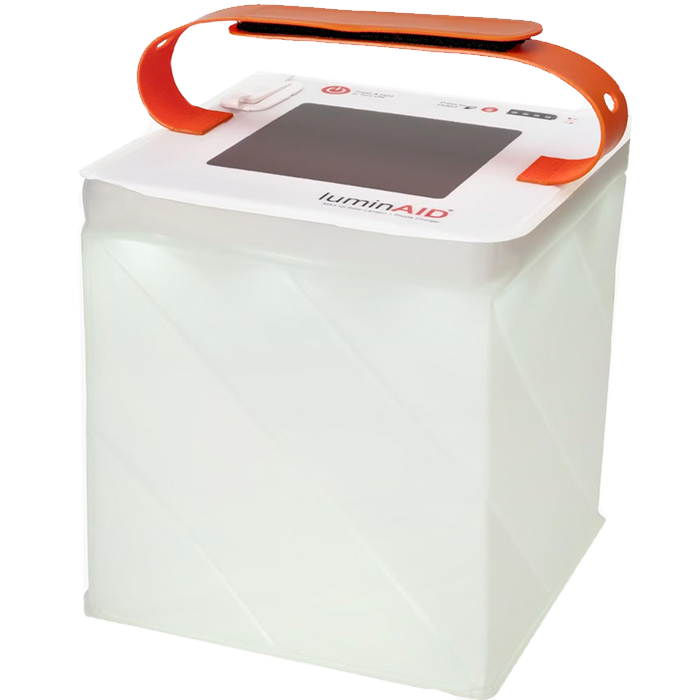
LuminAid Packlite Max 2-in-1
Best Lantern Overall
CleverHiker Rating:
4.8/5.0
Price:
$60
Weight:
12.5 oz.
Lumens:
150
Pros
- Solar Rechargeable
- Lightweight
- Collapsible
- USB port for external device charging
Cons
- Less bright
- Not as many lighting modes
The LuminAid Packlite Max 2-in-1 lantern combines functionality and portability, making it an excellent choice for a backcountry light. The Packlite Max features a simple and intuitive design that’s easy to operate right out of the box.
The power button turns the lantern on and off, cycles through four brightness settings and a flashing mode, and features a light indicator for battery life. The standout feature of the lantern is its collapsible design. When pressed into a compact square, the LuminAid inflates into a cube, offering 360 degrees of diffused white light. Weighing 12.5 ounces and being collapsible, it’s a lightweight option that easily stows into the side of a pack or pocket. Its build is waterproof and durable.
With a maximum output of 150 lumens, it’s not the brightest option we tested. The light radius is quite small, but we found it effective for cooking in the dark, and at close range, we could read using its lowest setting.
The lantern is USB-C rechargeable and also features a solar panel on top for natural recharging. Although we found solar charging to be slower than using USB, we appreciated how easy it was to strap the Packlite Max to the top of our pack and recharge while hiking. The lantern also includes a USB 2.0 port for charging external devices, making the solar capability a handy backup to a power bank. It has excellent battery life, lasting up to 50 hours on the lowest setting and up to 5 hours on the highest. We were able to fully recharge our phone while still having power left for lantern use.
Able to withstand rough conditions while maintaining a light weight and offering useful features, the LuminAid Packlite quickly became the lantern we reach for to illuminate nights of both car and tent camping in the mountains. With features and portability ideal for backpacking trips, it’s a lantern well-suited for the backcountry and beyond.

BioLite AlpenGlow 500
Most Feature Rich Lantern
CleverHiker Rating:
4.7/5.0
Price:
$80
Weight:
13.4 oz.
Lumens:
500
Pros
- Multitude of lighting modes
- Sleek, stylish design
- USB port for external device charging
Cons
- Heavy for size
- Less portable
The BioLite AlpenGlow 500 embraces freedom of choice by offering the widest range of color options and brightness levels among the lanterns we tested. Its sleek, rounded design and frosted globe create a diffused glow, while still delivering an impressive 500 lumens. Each mode is dimmable, with the ability to reduce brightness down to 5 lumens, offering great flexibility for different lighting needs.
The AlpenGlow has four main modes: cool white, warm white, single color, and multicolor. Its secondary modes include fireworks, single color cycling, single side light, candle flicker, and multicolor party. In both the single color and multicolor modes, output is fully customizable, offering options ranging from sunset gradients to solid hues that cover the entire color spectrum.
Our biggest hangup with the lantern was its somewhat complicated method of switching between settings. The single button on top of the lantern acts as a power switch and also lets you cycle through modes. Holding the button changes colors or adjusts the light’s brightness, and shaking the lantern activates the party and fireworks modes. However, figuring out exactly how to make these changes was confusing.
The AlpenGlow is USB rechargeable and also offers a port for charging phones and other devices, making it more practical than just having a stylish design. Weighing 13.4 ounces, we found it too heavy to carry for miles on a trail, but it became a favorite during car camping as a useful light for cooking at the campsite and for reading while relaxed in bed in the car.
The incredible customizability of the BioLite’s color and output sets it apart from other lanterns, while its features and bright light make it a stylish and practical choice for everything from car camping and van life to evening backyard gatherings.
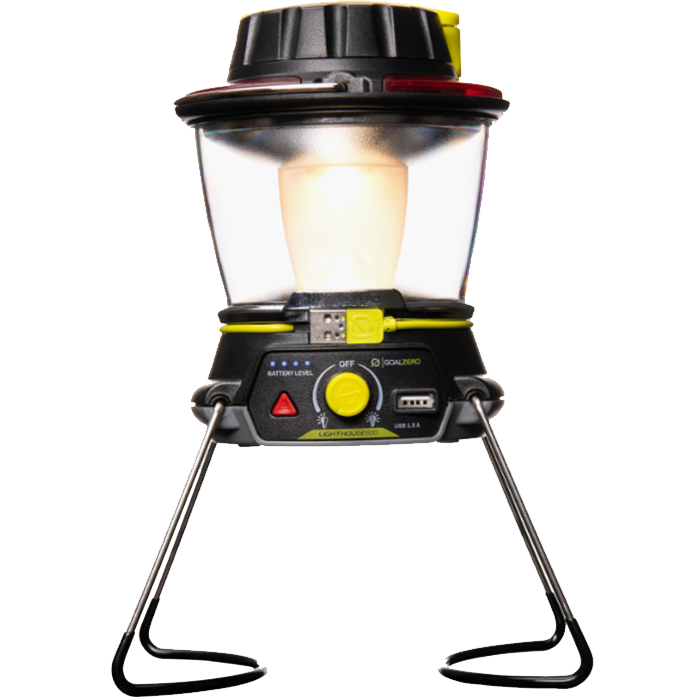
GoalZero Lighthouse 600
Most Versatile Lantern
CleverHiker Rating:
4.6/5.0
Price:
$80
Weight:
1 lb. 1.6 oz.
Lumens:
600
Pros
- Hand crank for manual recharging without power
- USB port for external device charging
- Several options for hanging and self-supported standing
Cons
- Pricier
- Heavy
The GoalZero Lighthouse 600 combines practicality, user friendliness, and functionality in a powerful, compact design. Its 600 lumen output is much brighter than most lanterns we tested. We wish GoalZero had chosen a frosted globe instead of a clear one to soften the light – the Lighthouse’s brightness is strong and reaches several feet in all directions.
During a road trip through the Rocky Mountains, we relied heavily on the Lighthouse as our main light source while preparing meals at our campsite. The lantern effectively illuminated our cooking area and offered plenty of visibility for detailed tasks. A built-in top handle made it easy to hang from our overhead tarp, while surprisingly sturdy wire legs provide a raised option when placed on a table or flat surface.
Unlike other products, the Lighthouse 600 features a split bulb that can be used as either half or the entire bulb, with both options being fully dimmable. This provides greater control over light output and direction. We often used the half bulb setting when near others, allowing us to keep the brightness necessary while preventing unwanted light from spilling into other campsites.
GoalZero designed the Lighthouse 600 for maximum ease of use. It operates with a single dial, which, when turned in either direction, activates the half or full bulb settings and dims the lantern up or down. An attached USB cable wraps around the body of the lantern for plug-and-play charging, eliminating the need for extra cables. The handle and legs fold neatly when not in use to keep a compact shape.
Although GoalZero emphasizes the Lighthouse’s compatibility with their external solar panels, built-in solar charging would have enhanced the lantern’s overall quality. Nevertheless, a key feature of the Lighthouse 600 is the integrated hand crank, which allows for immediate manual recharging and serves as a reliable backup in critical situations.
The Lighthouse is too bulky and heavy to be a practical backpacking option, but its range of features, ease of use, and brightness make it suitable for various environments, from outdoor adventures to emergencies.
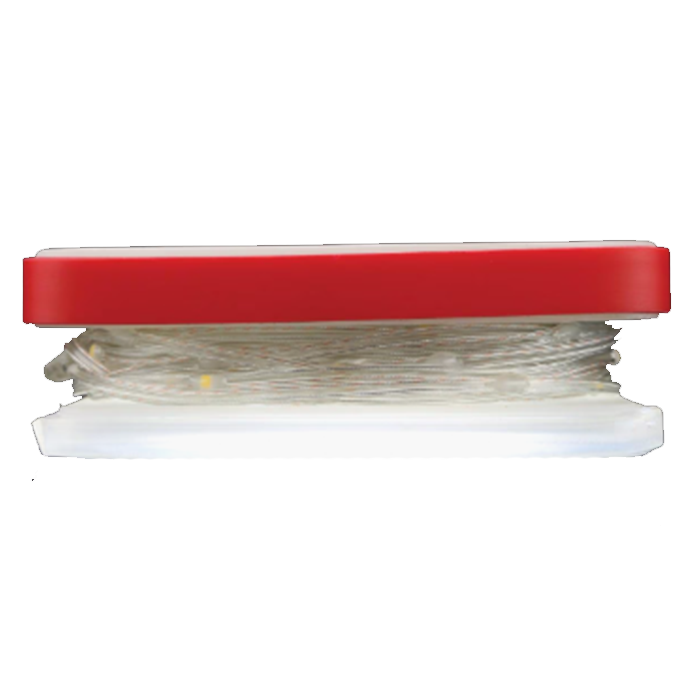
LuminAid Solar String Light
Best String Lights
CleverHiker Rating:
4.4/5.0
Price:
$66
Weight:
14.1 oz.
Lumens:
300
Pros
- 32’ string light for illuminating a larger area
- Doubles as a lantern and string light
- Solar rechargeable
- USB port for external device charging
Cons
- Not as many lighting modes
- More expensive
Crisscrossing tree branches with strands of light, it’s a bit of a stretch to call string lights a lantern, but the LuminAid Solar String Light offers the best of both worlds by combining yards of twinkling string lights with a compact lantern. At first glance, the Solar String Light looks very similar to the Packlite Max from LuminAid: a white square with a solar panel on its face.
However, instead of inflating into an illuminated cube, the opposite side of the Solar String Light functions as a single panel lantern. Sandwiched between the two square panels is the string light, which, when uncoiled, extends to 32 feet of thin, illuminated wire.
The lantern and string lights can be used either together or separately. The lantern offers 300 lumens at its brightest setting, while the string lights have a maximum output of 40 lumens. The lantern’s light is strong, but since it has only a single panel, it emits light in one direction only, rather than the full 360-degree spread like other lanterns.
The lantern is most effective when used as an overhead light (with a built-in handle that makes hanging easy), rather than sitting it on its side, where its light spread is limited. At 32 feet, the string lights can cover a fairly large area. During testing, we were able to wrap them inside our van and cover a section of our yard with enough space for several guests.
Though somewhat heavier than the other offering from LuminAid, the compact design of the Solar String Light makes it easy to pack. Most of our backpacking trips are in the Eastern Sierra, where trails above 10,000 feet and granite landscapes mean fewer trees.
The lack of places to hang a string light makes it a less appealing option for use in higher elevation environments, but its warm glow proves attractive for lighting up tree-lined campsites or for stringing up in the backyard or inside a van. With solar and USB rechargeability, a USB port for external device charging, and the dual function as a lantern and string light, the LuminAid Solar String Light provides the best of both worlds.

LightUpCamp LED Solar Powered Foldable Camping Light
Best Combination Lantern
CleverHiker Rating:
4.4/5.0
Price:
$72
Weight:
11.2 oz.
Lumens:
2400
Pros
- Extremely bright
- Easily packable
- Solar rechargeable
- Dual lantern and flashlight function
Cons
- Narrower spread of light
- Fewer lighting modes
Hardly larger than a smartphone when folded, the LightUpCamp LED Solar Powered Foldable Camping Light packs a serious brightness punch with a 2400-lumen light panel that also functions as a high-intensity flashlight. In a uniquely designed format, the LightUpCamp lantern consists of two rectangular light panels that open like a book.
At its maximum setting, the 2400-lumen output more than doubles that of any other lantern we tested. We didn’t find this highest setting necessary when camping, but it could be useful in emergency situations. The lantern has two other modes, which offer lower (but still very bright) levels of light, which worked especially well for reading at night.
Though not as blinding as the panel lights, the flashlight on the LightUpCamp cuts through the darkness, with a beam extending over a dozen feet and a wide spread of light that can effectively illuminate stretches of trail.
The rectangular foldability of the LightUpCamp differs from the round shapes of most lanterns, which has both advantages and disadvantages. The lantern cannot open beyond 200 degrees, limiting its illumination area. When hung overhead, this isn’t a problem, but the more focused direction of the panels makes it harder to light a larger area when the lantern is placed on its side on a picnic table or similar surface.
Although its opening width is limited, its foldable design is an advantage. When closed, the lantern remains very compact, with a slim profile that easily fits into the gaps between gear. One of the lighter products we tested, we clipped it to the outside of our pack using its built-in handle, which also functions as a stand, and barely noticed it even after miles of hiking.
With the added bonus of a solar panel and a USB port for charging, the LightUpCamp Foldable Camping Light is a versatile option designed to meet your needs during camping or emergencies, serving as both a lantern and flashlight. Although its unconventional design sets it apart from other lanterns, it provides powerful illumination in a lightweight package perfect for travel or taking on the trail.
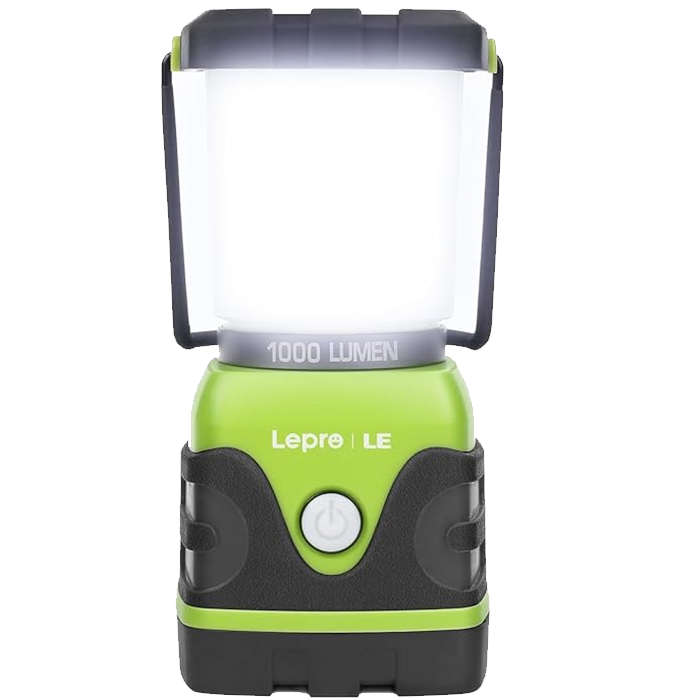
LE 1000LM LED Lantern
Best Lantern for Emergencies
CleverHiker Rating:
4.3/5.0
Price:
$29
Weight:
14.1 oz.
Lumens:
1000
Pros
- Very bright
- Easy to use
- Affordable
Cons
- Heavy
- Not rechargeable – uses bulky D batteries
Offering a maximum output of 1000 lumens, the LE 1000LM LED Lantern is one of the most powerful lanterns we tested, making it ideal for emergencies and other situations where brightness is essential. At its highest setting, the light from the LE extends for a couple of dozen feet in all directions. In our testing, it successfully lit up an entire campsite area, and it was possible to comfortably read from the lantern’s light several feet away.
With a squat rectangular shape, the lantern is operated by a single button at its center. Pressing the button turns the lantern on, cycles through its settings (daylight warm, warm white, full brightness, and flashing), and turns it off. The frosted globe diffuses the light without reducing its intensity; however, the lantern cannot be dimmed and remains at full brightness in all modes. While the lantern is ideal for lighting a large area, its brightness can be somewhat harsh and overpowering in smaller spaces or when close to others, such as at a campground.
The biggest drawback of the LE 1000LM is its chargeability. The lantern is not rechargeable and solely relies on three D batteries. These batteries can power the lantern for up to 12 hours—an impressive burn time compared to other models, which provide lower light settings for much less time.
However, the batteries are bulky and heavy, increasing the total weight of the lantern and potentially adding extra ounces with spare batteries. Although too heavy for backpacking, the affordable price, long burn time, and impressive brightness of the LE 1000LM LED Lantern make it a strong choice for the darkest situations.

GoalZero Lighthouse Micro Flash
Most Portable Lantern
CleverHiker Rating:
4.1/5.0
Price:
$35
Weight:
2.4 oz.
Lumens:
150
Pros
- Functions as a flashlight and a lantern
- Lightweight
- Portable
Cons
- Not very bright
- Offers smaller radius of light
Both flashlights and lanterns serve their purposes, and the GoalZero Lighthouse Micro Flash solves the dilemma of choosing one over the other by combining them into a single, highly portable device. Compact enough to fit in your hand and weighing only 2.4 ounces, the Micro Flash is the smallest lantern we tested by a significant margin.
Its tiny build and extremely light weight position it as a perfect backpacking light source, and it easily slips into any nook in our pack when hiking overnight. Its weight is barely noticeable even after miles of walking. A small hook on the top of the lantern folds up to clip into the ceiling of a tent or, when sitting at camp, it stands independently on flat ground.
Despite its small size, the GoalZero offers several options for output. The built-in flashlight on top of the lantern can be set to high or low, with a maximum of 115 lumens, providing a wide beam that illuminates over a dozen feet in the direction it’s pointed. The lantern section has four bulbs, which can be used all together or just two. When all four bulbs are at maximum, the Micro Flash produces 135 lumens, which is less than most lanterns tested, but it is more than sufficient for a small setup when cooking alone on the trail or for reading at night in a tent.
A USB connector flips out from the bottom of the lantern for easy built-in charging, and simply pressing and holding the power button quickly dims both the lantern and flashlight. The GoalZero Lighthouse Micro Flash eliminates the need to choose between a lantern and a flashlight, combining two useful light sources into one small but powerful device. Although its modes are limited, its functionality makes it the ultimate lightweight backpacking lantern you can carry in your pocket.
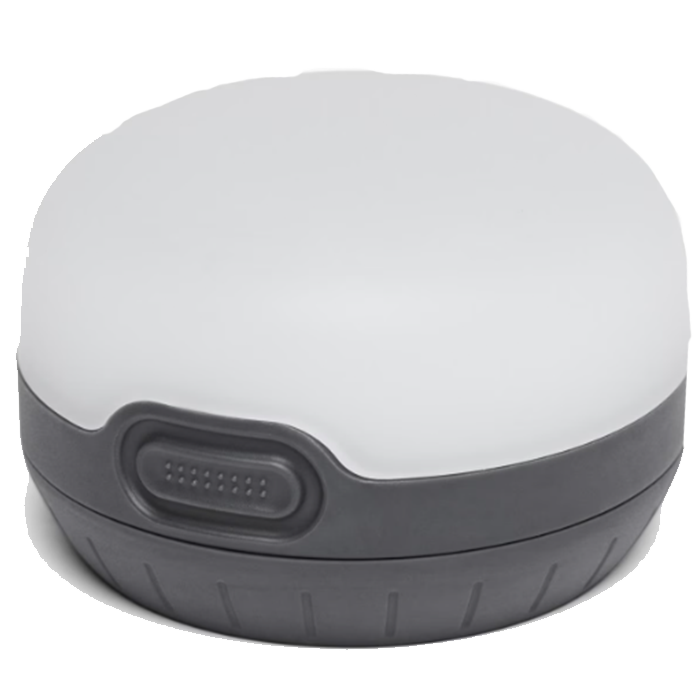
Black Diamond Moji
Most Budget-Friendly Lantern
CleverHiker Rating:
4.0/5.0
Price:
$30
Weight:
4.2 oz.
Lumens:
200
Pros
- Affordable
- Lightweight
- Small and easily portable
Cons
- Rechargeable battery sold separately
- Not very bright
Coming in a palm-sized package perfect for backpacking, the Black Diamond Moji minimizes weight and cost. The lantern measures a couple of inches in diameter and has a compact, rounded shape that easily fits into pockets and packs. Weighing only 4.2 ounces, it is significantly lighter than most of the lanterns we tested.
During our hikes through the rugged terrain of the Eastern Sierra, we had no trouble finding a place to stow the Moji and felt it had a negligible impact on our pack weight.
Although the Moji is small, it doesn’t compromise on brightness. Its highest setting delivers up to 200 lumens. It may not be the brightest option out there, but we were impressed by how much light it provided while remaining compact.
Up close, it’s effective for detailed tasks that need more visibility, like reading. We also found that it more than adequately lit up our campsite for cooking after a day on the trail.
Black Diamond keeps things simple with the Moji. The lantern has three brightness settings: high, medium, and low, and its diffused cool white light is purely practical — you won’t find any specialty settings or fancy features on the Moji.
In keeping with its functional nature, this lantern is designed to be weather-resistant, and although we didn’t experience inclement weather during testing, we found numerous reviews praising its ability to withstand wet conditions.
The Moji operates on three AAA batteries or a rechargeable battery from Black Diamond that is sold separately. Despite this potential extra cost, it remains one of the most affordable lanterns available. Combining style and function in a perfectly portable design, the Moji is a great addition to a backpacker’s gear without costing too much.

Coleman Rugged Rechargeable
Most User-Friendly Lantern
CleverHiker Rating:
3.9/5.0
Price:
$76
Weight:
1 lb. 14.4 oz.
Lumens:
400
Pros
- USB Rechargeable
- Fairly bright
- Easy to use
Cons
- Bulky and heavy
- Only two lighting modes
When you’re looking for the essentials, the Coleman Rugged Rechargeable focuses on the basics with a lantern that’s simple to use and a dependable light source. Resembling the lantern featured in the Coleman logo, the Rugged Rechargeable has a classic lantern design with a modern upgrade.
Featuring a wide base, a large globe, and a pivoting top handle, the Coleman is an ideal centerpiece for sitting around the picnic table. Its plastic construction makes it lighter than its original metal Coleman counterparts, but its size and shape remain bulkier than other brands’ slimmer, more rounded designs.
A dial functions as the lantern’s control, with options set to a simple “low,” “off,” and “high,” making it the easiest to operate among the lanterns we tested. Although we prefer a frosted globe for a softer, diffused light, the Coleman’s clear cover allows its maximum 400-lumen brightness to disperse fully, providing a bright glow that extends several feet. The bottom of the lantern cleverly unscrews to reveal a convenient storage compartment for the cables needed for USB charging.
The size and weight of the Coleman make it impractical for backpacking, but on our car camping trip, we were able to store it in a tub filled with cooking gear, making it easy to set up and turn on for pre-sunrise breakfasts and lighting the campsite when preparing dinner after a day of hiking. With its wide light spread and foolproof design, the Coleman Rugged Rechargeable combines classic style with reliable performance.
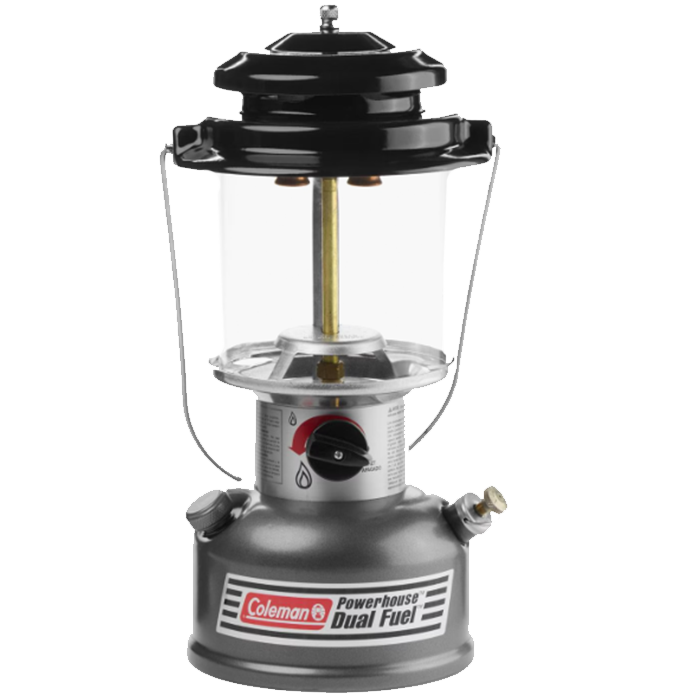
Coleman Powerhouse Dual Fuel
Lantern with the Best Vibes
CleverHiker Rating:
3.6/5.0
Price:
$110
Weight:
4 lb. 8 oz.
Lumens:
800
Pros
- Doesn’t rely on batteries
- Fuel provides heat
- Classic design
Cons
- Requires carrying fuel
- Heavy and bulky
- Glass construction is fragile
When you think of a lantern, the old-school design of the Coleman Powerhouse Dual Fuel is probably what comes to mind. Unlike the battery-powered lanterns we tested, it burns hot using real fuel. It’s a classic lantern that exudes vintage charm with a reliability that has stood the test of time.
Made from glass and metal, the Powerhouse is more delicate than its plastic counterparts and needs careful handling when it comes to storage and travel to prevent breakage. However, if treated with care, these high-quality materials are designed to last for decades.
Preparing the Coleman for use takes some time. Mantles—chemically coated fabric bags that give a gas lantern its characteristic glow—must be tied onto the burners. The bottom chamber of the lantern is carefully filled with fuel before being pumped to prime the lantern. To light the lantern, a long match must be slid through a hole beneath the glass globe as the gas control knob is turned on.
We ended up watching a few YouTube videos to make sure we followed each step of the process carefully, especially because of the presence of flammable materials and liquids. Setting up the Powerhouse is quite complex and not very child-friendly at first, but it gets easier with practice.
The Powerhouse is the only lantern we tested that avoids using batteries, relying solely on fuel instead. Unfortunately, it needs a specific liquid gas (or unleaded gasoline), and the lantern isn’t compatible with the canisters typically used by backpacking and camp stoves.
The benefit of gas, though, is heat production. The lantern not only provides light but also warmth, which we found comforting on chilly evenings. The Powerhouse is rated with Coleman’s “All Season Strong” technology, allowing it to be used in all types of weather conditions.
When fully filled, the Coleman burns for between 5 and 20 hours, depending on the setting. At maximum gas output, the lantern provides 800 lumens of bright light. Bright enough to illuminate an entire backyard, we especially appreciated the warm, natural glow of the lantern.
Its heavy weight and glass parts restrict its uses, but the Coleman Powerhouse Dual Fuel stands out with its vintage look that is both charming and practical. With proper care, the Powerhouse can last a long time. Without any tech gimmicks or batteries that wear out, it’s highly dependable—as long as you have fuel!
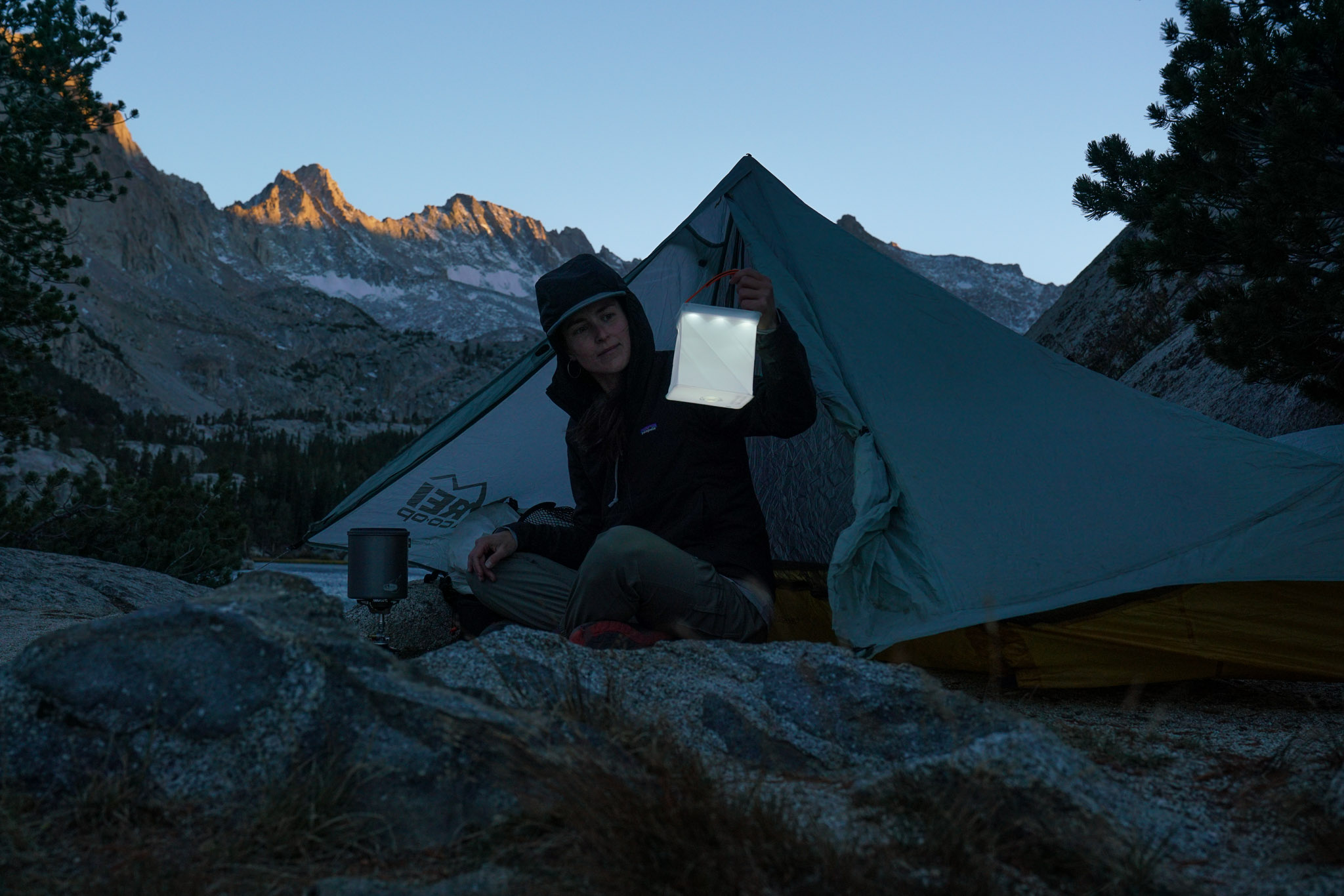
Product Comparison Table
| oSort | Product | Price | Weight | Lumens | Charging Options | Illumination & Light Quality | Battery Life | Portability | Features | Ease of Use | 0 |
LuminAid Packlite Max 2-in-1 View at REI View at Amazon |
$60 | 12.5 oz. | 150 | USB, Solar | 3.9 | 4.8 | 4.8 | 4.6 | 4.6 | 1 |
BioLite AlpenGlow 500 View at REI View at Amazon |
$80 | 13.4 oz. | 500 | USB | 4.5 | 4.4 | 4.3 | 4.8 | 4.0 | 2 |
GoalZero Lighthouse 600 View at REI View at Amazon |
$80 | 1 lb. 1.6 oz. | 600 | USB, Hand Crank | 4.6 | 4.7 | 4.1 | 4.7 | 4.5 | 3 |
LuminAid Solar String Light View at REI View at Amazon |
$66 | 14.1 oz. | 300 | USB, Solar | 4.3 | 4.8 | 4.6 | 4.4 | 4.2 | 4 |
LightUpCamp LED Solar Powered Foldable Camping Light View at LightUp Camp |
$72 | 11.2 oz. | 2400 | USB, Solar | 4.9 | 4.6 | 4.7 | 4.5 | 4.4 | 5 |
LE 1000LM LED Lantern View at Amazon |
$29 | 14.1 oz. | 1000 | D batteries | 4.8 | 4.0 | 4.2 | 4.0 | 4.7 | 6 |
GoalZero Lighthouse Micro Flash View at REI View at Amazon |
$35 | 2.4 oz. | 150 | USB | 3.9 | 4.3 | 4.9 | 4.2 | 4.1 | 7 |
Black Diamond Moji View at REI View at Amazon |
$30 | 4.2 oz. | 200 | AAA batteries, USB | 4.1 | 4.1 | 4.8 | 4.1 | 4.2 | 8 |
Coleman Rugged Rechargeable View at Amazon View at Walmart |
$76 | 1 lb. 14.4 oz. | 400 | D batteries, USB | 4.4 | 4.1 | 3.8 | 3.9 | 4.7 | 9 |
Coleman Powerhouse Dual Fuel View at REI View at Amazon |
$110 | 4 lb. 8 oz. | 800 | None – Gas powered | 4.7 | 3.8 | 3.5 | 3.8 | 4.3 |
|---|
var resetClicked = false;
// When the Reset Table button is clicked, use sortable to reset to the oSort column.
document.querySelector(‘#resetSort’).addEventListener(‘click’, function() {
// If reset has been clicked, do nothing
if (resetClicked) {
return;
}
// Get the defaultSort element and click it to reset sort to the original load order.
const el = document.getElementById(‘defaultSort’)
if (el) {
el.click();
resetClicked = true;
}
});
// Add event listener to all sortable headers to reset the resetClicked flag
var headers = document.querySelectorAll(‘.sortable th’);
headers.forEach(function(header) {
header.addEventListener(‘click’, function() {
resetClicked = false;
});
});

How We Test & Methodology
To thoroughly examine these lanterns, we evaluated each product based on factors such as illumination & light quality, chargeability, battery life, portability, features, and ease of use – considering these aspects as indicators of a lantern’s overall usefulness and effectiveness.
Our testing process included hiking into California’s Sierra Nevada with the lanterns for tent camping and taking them on a road trip to the Rocky Mountains.
Over weeks at elevation and in weather conditions ranging from clear to rainy, the lanterns served as our main source of light for cooking, reading, and hanging out at camp. We even used them around the house and during evenings in the backyard.
Illumination & Light Quality
Perhaps the most important feature of a quality lantern is light output, which indicates how much light it produces. We measured the number of lumens (a unit of light brightness) each lantern emitted and observed the intensity and distribution of the light.
To evaluate these aspects, we turned on the lantern in a dark environment and observed the radius of the light, noting how far it extended before fading into darkness. We also used vision-critical tasks—such as reading a book—to assess the amount of usable light provided by the lantern.
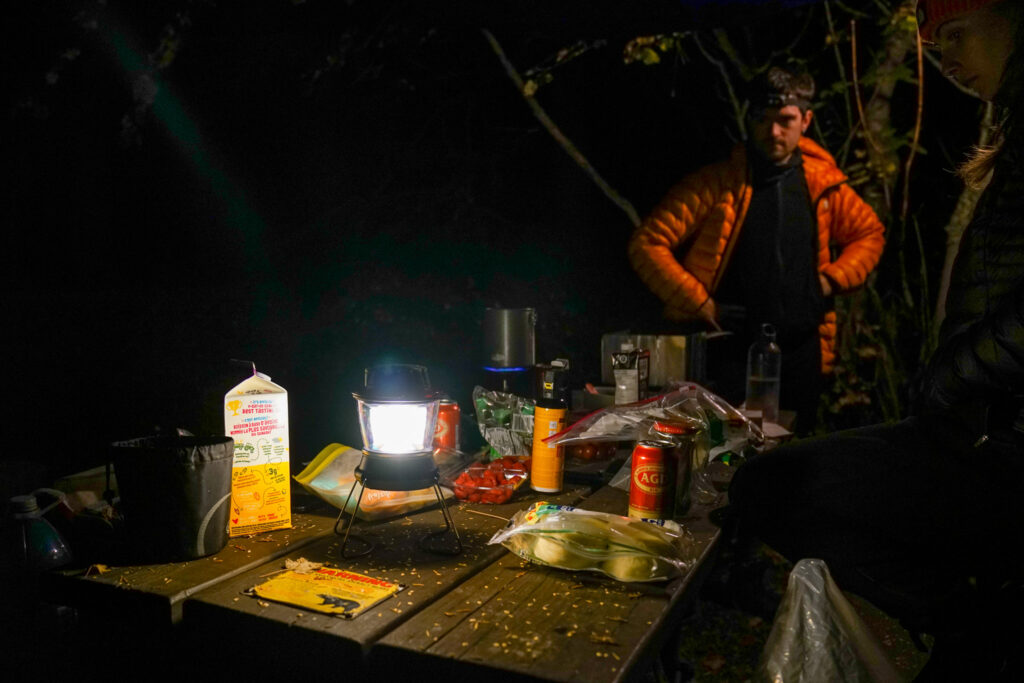
Battery Life
Lanterns need power to work, which gets more difficult when you’re off-grid. How long a lantern can run on power and how easily it charges are important, especially when shore power isn’t available.
In our testing, we turned on fully charged lanterns at their various settings and monitored how long they stayed lit before dying. For rechargeable options, we noted the speed of different charging methods, such as USB or solar, and how they varied. Overall, we prioritized lanterns that offered multiple charging options, finding them the most versatile in a range of environments.
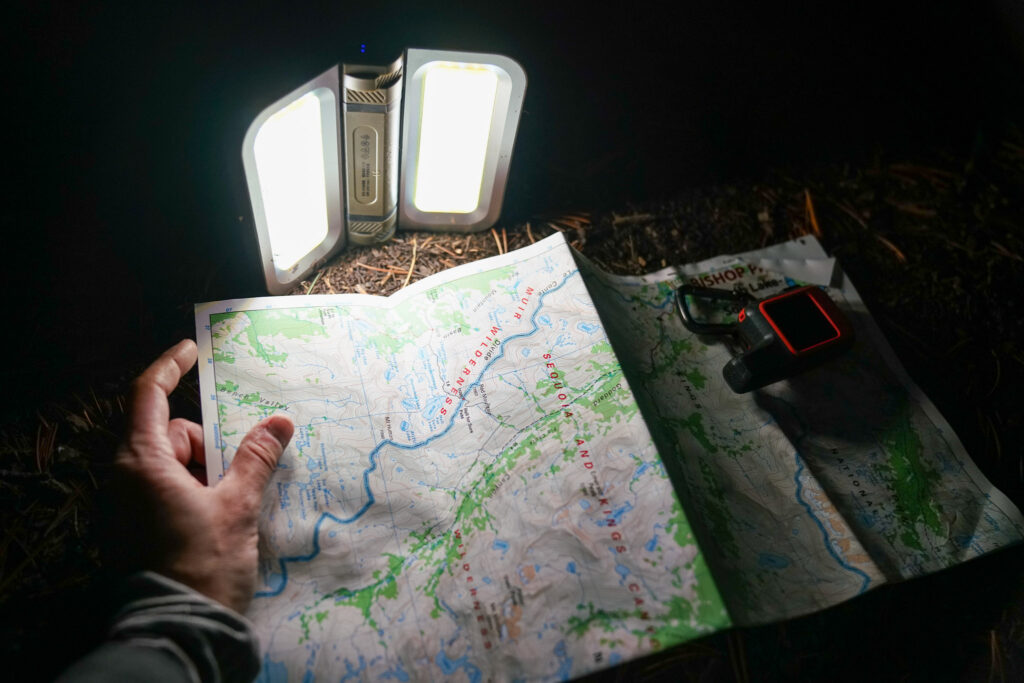
Portability
When you’re camping, every ounce matters. Especially when backpacking, lanterns can be a heavy load for your pack, particularly when lighter headlamps are available. We weighed each lantern and considered how its weight might affect its use, such as whether it’s better suited for car camping or backpacking.
We also examined the material construction and shape of each product to see how easily it can be packed or stowed for travel. While hiking with the lanterns over miles of trail in the Sierra Nevada, we evaluated whether the extra weight was justified by the illumination it provided.

Features
The features metric examines the settings and lighting modes offered by a lantern. Although they often provide more light than a headlamp, what can also distinguish a lantern is the wider range of illumination options. We first assessed the available settings on each lantern, including flashing or emergency light patterns, dimmability or brightness levels, party mode or other “mood” options, and red light or other color choices.
We put these settings to the test to see if they had practical use. Some lanterns also come with USB ports for charging external devices like phones or can double as a flashlight. In the ultralight spirit of only carrying items with multiple functions, these extra features give the lanterns an added advantage. We observed how these features affected aspects such as run time and how quickly devices could be recharged.

Ease of Use
We appreciate a lantern that’s easy to use and value products with a practical, intuitive design. To assess user-friendliness, we tried operating each lantern without reading the instruction manual to see if we could figure it out on our own. We tested turning the lantern on and off, cycling through any different modes, and adjusting the brightness before referencing the directions.
Although we always recommend reading the manual to fully understand a product, lanterns are often used in less-than-ideal lighting conditions, and easy operation ultimately means less fumbling around in the dark. We also examined each lantern’s exterior for features such as handles, feet, and hooks that might help in hanging or setting up the lantern for different situations.
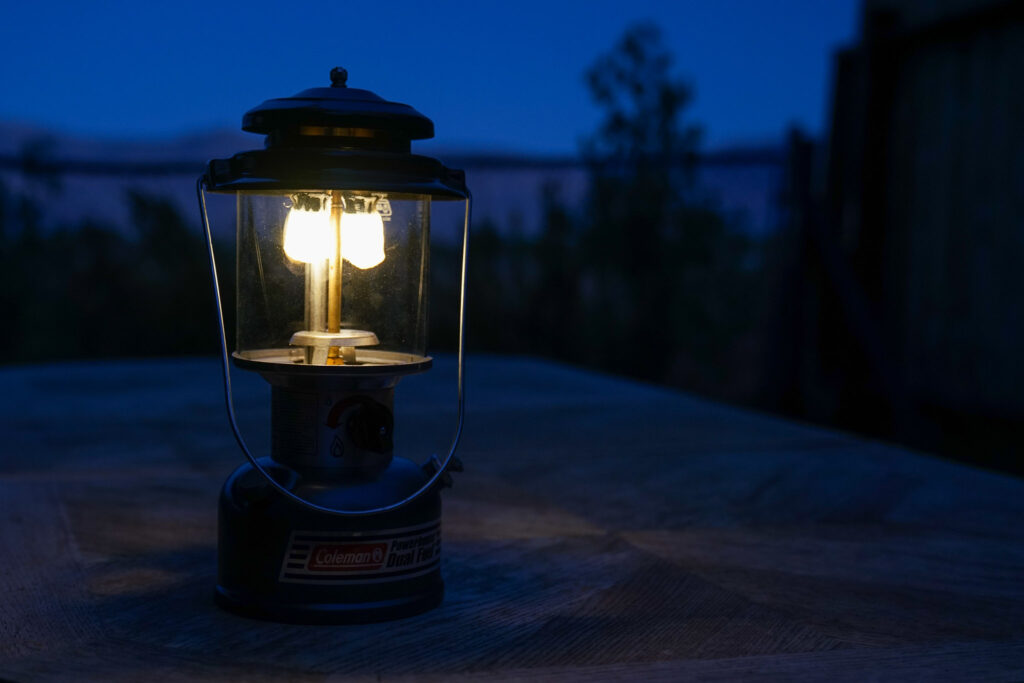
Why Trust CleverHiker
At CleverHiker, we did a deep dive into 35 different products from top brands to create this gear guide featuring our best picks and highlighting lanterns suitable for a wide range of uses.
With years of experience backpacking and kayak touring, gear analyst Marion Tucker understands the importance of a reliable light source in the backcountry and the key features that make a lantern stand out. She tested these products side by side, using them tent-side while camping in California’s John Muir Wilderness and Kings Canyon National Park.
As her primary source of light while backpacking, Marion was able to examine the key features of each product. The testing period overlapped with a road trip to the Rocky Mountains, where Marion could test how each lantern performed while car camping, providing additional insight into each product’s functionality.

Analysis & Results
We review lanterns based on key aspects such as value, illumination quality, chargeability, battery life, portability, features, and ease of use. Continue reading to see how our recommendations highlight these categories.
VALUE
Lantern prices vary greatly depending on their shapes and sizes. While a higher price might indicate better materials or more features, it doesn’t always mean the lantern is superior. Since budget is an important factor in purchasing decisions, we consider how a lantern’s price and performance combine to show its overall value.
The LuminAid Packlite Max 2-in-1 is a standout when it comes to delivering an excellent product at an affordable price. Sitting at the low end of the mid-price range, the Packlite skillfully blends quality with cost-effectiveness. It’s the lantern we kept returning to for everything from camping to providing extra light around the house. Its collapsible design and relatively light weight make it ideal for travel and backpacking, while also serving as a practical light source whenever you need a boost of brightness. Featuring a weatherproof exterior, a built-in solar panel, and the ability to charge other devices, the Packlite is versatile and designed for outdoor use. This lantern is durable, practical, and multifunctional — all at a reasonable price.
Similar to the LuminAid, we found ourselves impressed by the range of functionality and features offered by the GoalZero Lighthouse 600. Although it is slightly more expensive than the Packlite, it’s still not the priciest option available. For the cost, the Lighthouse 600 offers exceptional brightness and features a thoughtful design that seamlessly combines form and function. Its shape is sleek and compact, and the neatly tucked-away legs and top handle offer alternative ways to set up the lantern. With a maximum of 600 lumens, the Lighthouse 600 delivers strong illumination that can be easily adjusted. Its ability to operate at half or full brightness and full dimming capability allow you to customize the light to your specific needs. Practical features like the hand crank, built-in USB charging cable, and extra USB port improve its usability, making it suitable for a variety of settings
Illumination & Light Quality
Brightness is the key feature of a lantern, and lumens, a measure of light output, are a clear indicator of a lantern’s power. We were blown away by the LE 1000LM LED Lantern and LightUpCamp LED Solar Powered Foldable Camping Light, which, maxing out at 1000 lumens and 2400 lumens respectively, clearly outshone the other products. In our testing, we measured the distance a lantern could illuminate before losing brightness.
Both the LE and LightUpCamp’s brightness extended for over two dozen feet. When you need to light a larger area or during emergency power outages when your house is left in the dark, these lanterns with their high lumen outputs are powerful sources of brightness.
While brighter might be better in some cases, it’s not the only factor that affects a lantern’s performance. Light quality is also crucial, especially when a lantern is used to light a space and create a mood. The BioLite AlpenGlow 500 and GoalZero Lighthouse 600 do an excellent job blending brightness and quality. Housed in a frosted globe, the AlpenGlow produces a diffused, soft light that’s gentle on the eyes, while still offering a 500-lumen output bright enough for reading and detailed tasks.
Similarly, the Lighthouse 600 provides up to 600 lumens of warm, bright light. Although the clear, unfrosted globe delivers a harsher output than the AlpenGlow, we appreciated the split bulb feature on the Lighthouse 600, allowing you to use half or the full bulb, both fully dimmable. This unique feature gives you extra control over the lantern’s output, helping you direct the light more effectively. We often used the entire bulb when hanging the lantern overhead to prepare meals, but switched to just half the bulb when we didn’t want the light to spill onto neighboring campsites- all without diminishing the brightness of the active half.
Depending on the size of the space you need to light or the tasks you’re doing, you won’t always require the highest lumens available. While having a lantern with a higher lumen maximum can be helpful, we appreciated lanterns that also consider light quality and offer dimming options to adjust as needed.
Battery Life
We often use lanterns when overhead lights aren’t available, such as while camping, off the grid, or during a power outage. A lantern that stays lit for a long time and provides easy charging options once it dies is very useful when power isn’t readily accessible.
For this reason, we were especially interested in products that offered multiple ways to recharge and avoided the necessity of carrying disposable single-use batteries The lanterns from LuminAid, the Packlite Max 2-in-1 and Solar String Light impressed us with their easy-to-use USB ports for charging, along with the solar panels built into the lanterns themselves.
Although they charge more slowly than USB—especially in cloudy weather—the solar panels ensure the lantern will always have power. We took the Packlite Max backpacking and strapped it to the top of our pack so the solar panel could soak up the sun and passively charge as we hiked.
The Packlite also lasts for 50 hours on its lowest setting, which is much longer than similar-sized lanterns. The combination of a long-lasting battery and flexible charging options makes it especially useful for longer trips or when power access is unreliable.
Similar to the solar panels of the LuminAid lanterns, the GoalZero Lighthouse 600 marks itself as a lantern where no power is no problem. It is the only product we tested that features a hand crank, which, with a little elbow grease, allows for instant recharge wherever you are. The lantern is USB rechargeable, making it the most efficient and fastest way to recharge its battery. However, 1 minute of hand cranking provides 10 minutes of light when no other options are available or you want a quick arm workout.
Portability
Headlamps are often considered an essential for camping or backpacking trips, which can make it difficult to justify the extra weight or space occupied by a lantern. However, whether traveling alone or with a group, lanterns can light up a larger area and provide ambient light that headlamps cannot. Despite the specific role lanterns serve, when every ounce counts, it’s useful to find one that can be easily packed away without notice.
The GoalZero Lighthouse Micro Flash takes low profile to the max as the smallest lantern we tested. With its combination lantern and flashlight design, its conical shape resembles a miniature flashlight and is small enough to fit in your palm. We tossed it in our pocket, later using the flashlight part to guide us down a trail at night, and its light 2.4-ounce weight was almost unnoticeable. Being so tiny, it easily tucked into any available gap in our pack, removing the need to find a specific spot in a bag already filled with gear.
Though not as small as the Micro Flash, Black Diamond’s Moji keeps weight and size to a minimum, all while maintaining a brightness and spread that support its inclusion in a backpacking kit, versus simply relying on a headlamp. Its rounded orb-like shape still fits within the palm, and like the Micro Flash, it fit without notice into our pack’s available nooks and crannies. At 4.2 ounces, it’s lightweight without sacrificing light intensity.
Measuring 12.5 ounces, the LuminAid Packlite Max 2-in-1 seems a huge step up in weight compared to the Micro Flash and Moji, but it remains significantly lighter than most lanterns. While it may not qualify as “ultralight,” the Packlite’s design truly makes it one of the most portable options. Squished into a compact square, a valve on the bottom opens to let in air and inflate the lantern into a cube.
When not in use, simply press to deflate and reshape it into a flat square. Its ability to flatten and expand as needed makes it much easier to travel with, allowing it to fit into a side pocket or a pack. The compact design also allowed us to keep a low profile by attaching it to the outside of our pack and using the built-in solar panel to recharge.
Features
Features are the elements that give a lantern an extra edge, both practical and aesthetic. Boasting nine lighting modes, the BioLite AlpenGlow 500 is a powerhouse for customizing your lighting to fit your specific needs. Unlike other lanterns we tested, the AlpenGlow embraces color, providing a range of colored lights to choose from and multi-color gradient options when the goal is setting a mood rather than simply eliminating darkness.
When you need functional lighting, the AlpenGlow offers up to 500 lumens of dimmable cool and warm white light, including a gentle flickering “candle mode” on the warm light setting. With the various customization options in the AlpenGlow’s modes, BioLite recognizes that lanterns are not only practical for illuminating the dark but can also be essential for creating an atmosphere.
Though it lacks the BioLite’s range, the LuminAid Solar String Light employs a similar blend of function and aesthetic as a combination between a lantern and string lights. The tiny points of light hanging in strands across a campsite create a magical atmosphere.
However, most string lights are just that: a string of lights with a low lumen count that’s more decorative than brightening. Instead, LuminAid maintains the charming twinkle of a string light and combines it with the practical brightness of a lantern. Packaged as a compact square, the 32 feet of string light unwraps from between two panels, one of which is a light source providing up to 300 lumens of brightness. With its hybrid design, LuminAid offers the aesthetic mood of a string light and the functional brightness of a lantern in a single product, with each part able to be used separately or together.
Ease of Use
When you’re in need of light, it’s nice to have a lantern that provides easy and immediate relief without needing to fumble around in the dark. The LE 1000LM LED Lantern is about as simple as it gets for usage, operating entirely with a single button. Just press the button to turn the lantern on and off, and to cycle through its cool white, warm white, and maximum brightness modes. As long as the lantern already has batteries, it’s ready to use immediately, and the single button makes it foolproof.
The Coleman Rugged Rechargeable also favors simplicity in its design. A single dial offers three options: “off,” “high,” and “low.” With a quick turn, the lantern switches between settings and is easy to use in the dark.
Some of the lanterns we tested weren’t as “plug and play” right out of the box. There’s nothing wrong with taking the time to read instructions and learn how a product works, especially when it has multiple features. However, when you’re in the dark, it’s helpful to quickly figure out how a lantern functions and get immediate light.
Intuitive operation is a useful aspect of a lantern’s design, along with built-in features that make it easier to use. Many lanterns include hooks, handles, and feet that provide options for hanging or setting it up on a table or the ground. We especially liked the options available on the GoalZero Lighthouse 600, with its flat bottom, feet for raised illumination, and top handle for overhead hanging. While car camping, we put all three modes to use when cooking and hanging out at our campsite.

How to Choose a Lantern
There are a few key factors we suggest considering when selecting the lantern that best meets your needs.
Use
Knowing how and where you plan to use a lantern is a crucial factor in choosing the most helpful product. Are you hiking miles into the backcountry? Is the lantern in case of an emergency at home? Or are you simply looking to set the mood at your next backyard gathering? Where you are using a lantern and how you’re getting it to its destination will drastically impact your preference on size and weight.
For backpacking, the total weight and packability of a lantern are especially important, and features like external device charging and solar recharging become more valuable in backcountry settings. Lighting modes, whether flashing or color-changing, are less important for backpacking but appealing for close-to-home use, and when traveling by car, the weight of a lantern becomes a minor concern.
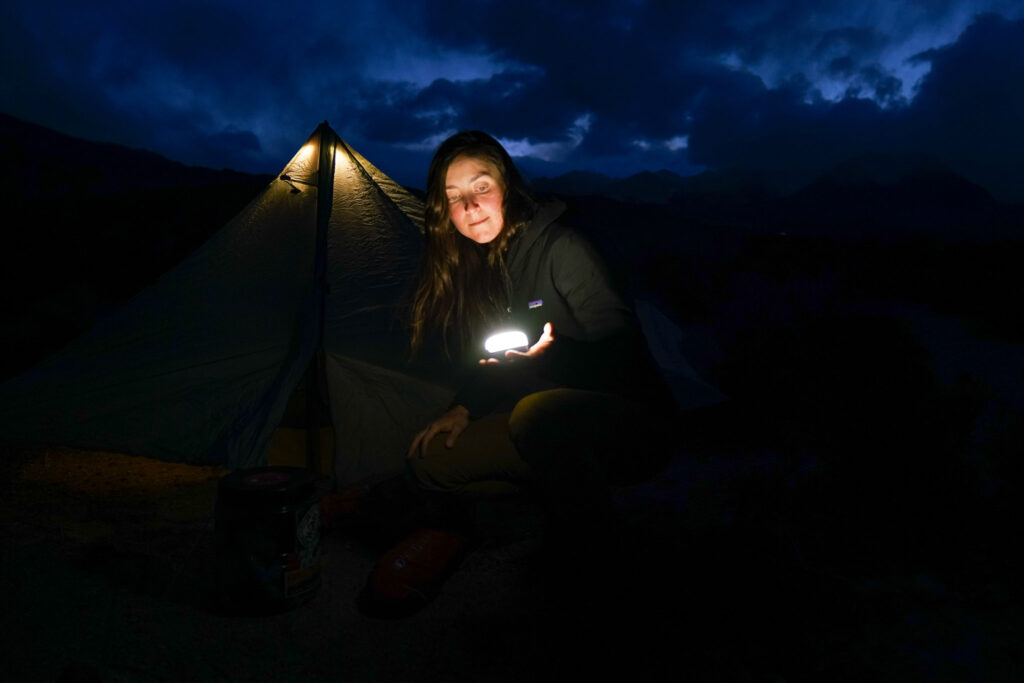
Durability
When choosing a lantern for different environments, it’s important to consider how its design and materials will affect how you use it. Glass is more fragile than plastic, making it a riskier option for rough roads or when packed into a bag.
Even plastic isn’t immune to damage, and the globes surrounding lantern bulbs can crack. For trips where you’ll face rougher conditions, lanterns with a compact design and sturdy materials are more suitable. If you mainly plan to use your lantern outdoors, it’s best to select an option with better weather resistance made from materials designed to handle moisture and varying conditions.
Durability also promotes longevity. Although they aren’t the most expensive gear, it’s not ideal to replace a lantern each year. Choosing a well-made, solidly built product increases the chances of it lasting for many years to come.

Lumens
Lumens measure a light’s brightness. However, having the highest lumen count doesn’t always mean a lantern is the best choice. Not all situations require intense brightness, and lower-lumen lanterns might be a better option, especially in smaller spaces or for tasks close at hand.
When using a lantern for emergency lighting or as the main light source for a large area, more lumens are preferable! The extra brightness helps distribute light more evenly for better visibility.
Lanterns with bulbs that emit 360 degrees of light also offer a wider range of illumination. We found the ability to dim a lantern and adjust the lumen output especially helpful.
While staying at a campground in Glacier National Park, we used a lantern as an overhead light while cooking, setting it to its brightest for the clearest and broadest light spread. Once the detailed tasks were finished, we appreciated being able to dim the light while sitting around the picnic table to eat; the lantern provided enough illumination for us without affecting nearby campsites.
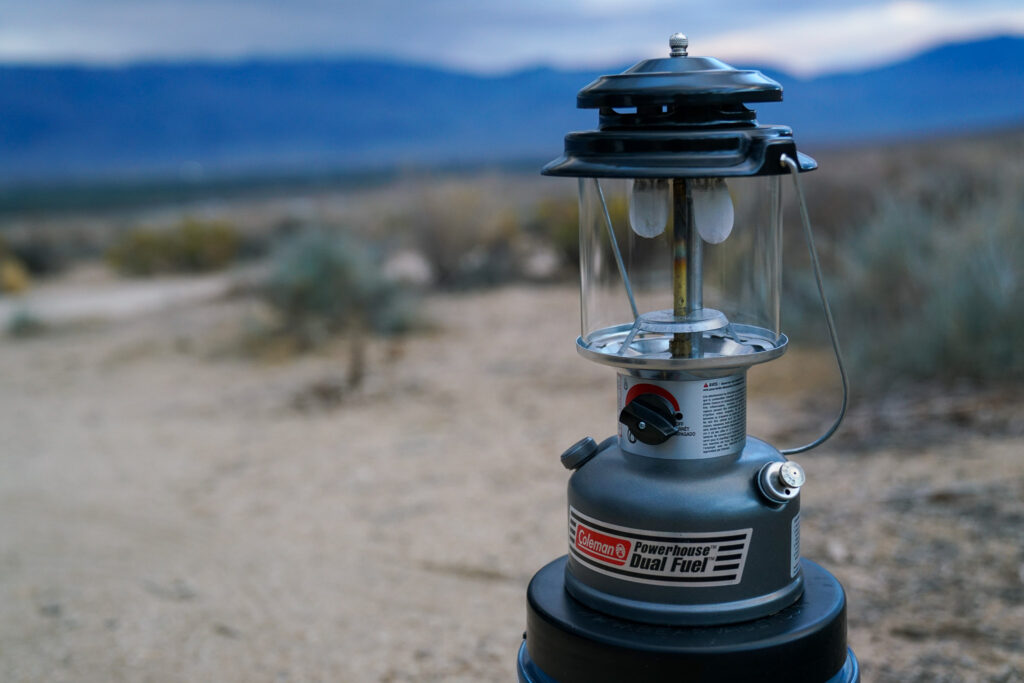
Batteries
Lantern power sources range from rechargeable internal batteries, single-use disposable batteries, and solar power. The ability to recharge a lantern’s battery greatly influences whether it is suitable for backcountry use. For backpacking, when access to power is limited or nonexistent, we prefer USB or solar rechargeable options.
Although we usually hike with a power bank, which serves as the recharging source for USB-powered lanterns, we especially appreciate lanterns that function as a power bank themselves. Lanterns equipped with a USB port for charging external devices are perfect for camping or emergencies, providing a backup to keep phones and other gadgets charged.
Although their burn times and resistance to colder temperatures are often better than rechargeable options, we found that lanterns using single-use batteries are unnecessary weight when backpacking, since they cannot be recharged. While ultimately disposable, D batteries last longer than AA or AAA batteries, but they are significantly heavier. It’s important to choose a lantern whose battery type fits into your charging system, whether on the trail or at home.
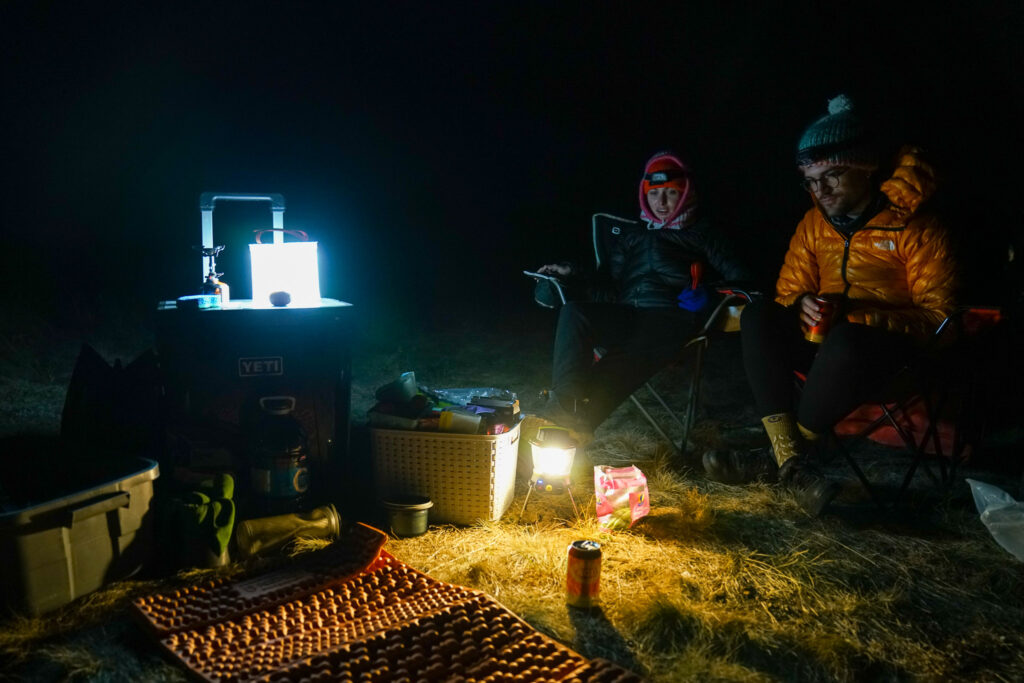
Conclusion
A good lantern is a light in the dark that provides the necessary illumination for activities around camp or outdoors even after the sun has set. We thoroughly examined how brightness, chargeability, portability, features, and ease of use were demonstrated in each lantern. Using these metrics as a framework, we tested each product in various environments to fully assess their functionality and performance. Our recommendations are supported by rigorous field testing and designed to help you find the perfect lantern for your needs.
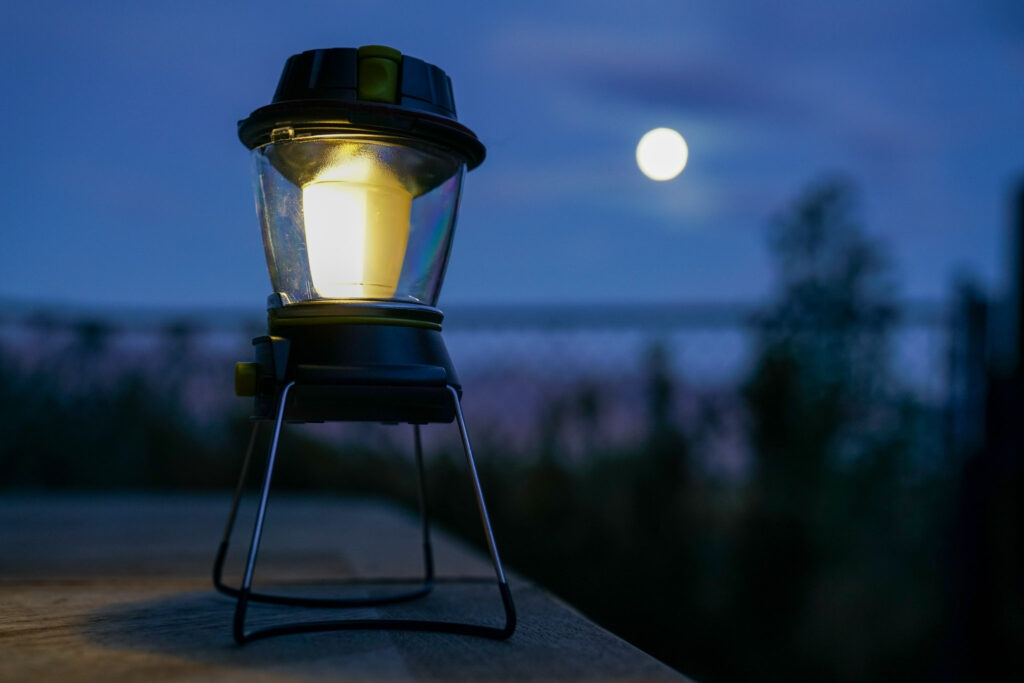
The post Best Camping Lanterns of 2025 appeared first on CleverHiker.


